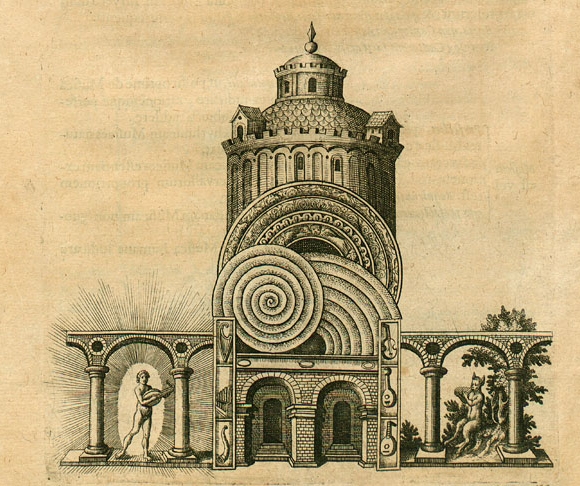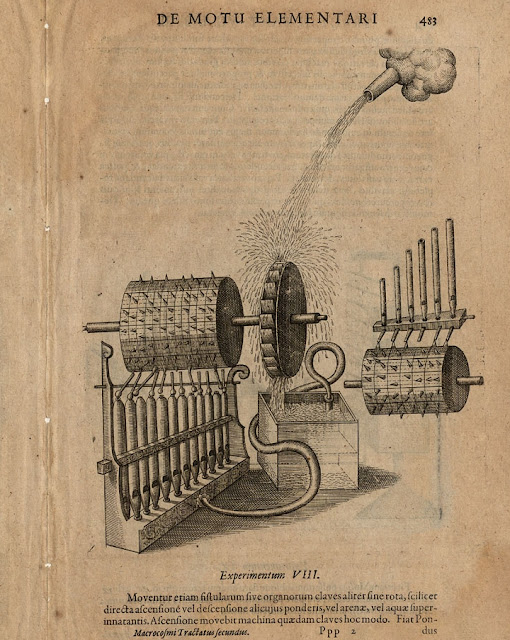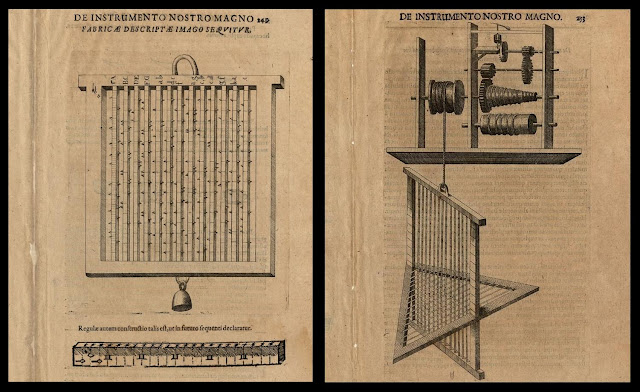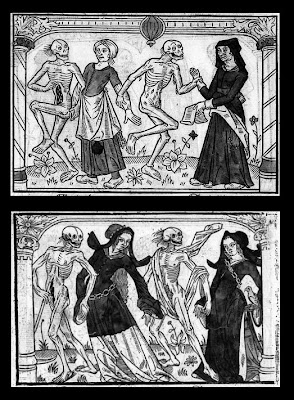IN: 'Costumes of all nations - 123 plates, containing over 1500
coloured costume pictures by the first Munich artists. 1913 Tyrolean'
coloured costume pictures by the first Munich artists. 1913 Tyrolean'

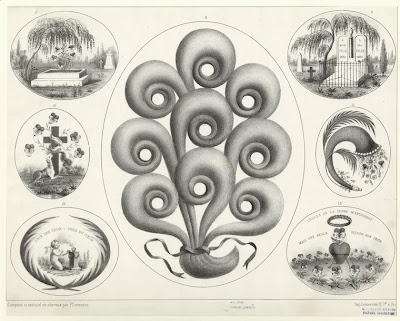
The above 2 are IN: 'Dessiné d'après les modéles en cheveux de
P. Florentin in Album de dessins en cheveux. 1870s'
(I had no idea that hair art/jewellery and death went together. But then again,
I had no idea that hair art even existed.) There are more images in this series.
[And just because I found it: 'A Bibliography of books & other materials
on gravestones, cemeteries, epitaphs, mourning, funerals, and
related subjects' at (where else) A Grave Affair]
P. Florentin in Album de dessins en cheveux. 1870s'
(I had no idea that hair art/jewellery and death went together. But then again,
I had no idea that hair art even existed.) There are more images in this series.
[And just because I found it: 'A Bibliography of books & other materials
on gravestones, cemeteries, epitaphs, mourning, funerals, and
related subjects' at (where else) A Grave Affair]

Deutsche Karikatur auf die hohen Haarfrisuren, am 1780.
IN: 'Die Frau in der Karikatur'. 1906.
IN: 'Die Frau in der Karikatur'. 1906.
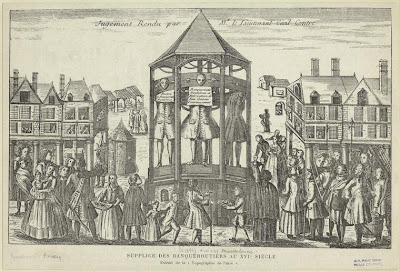
'Supplice des banqueroutiers [torment of the bankrupts]
au XVIe siècle. Le musée criminel - crimes et peines d ' autrefois.'
('1899' is pencilled below the picture)
au XVIe siècle. Le musée criminel - crimes et peines d ' autrefois.'
('1899' is pencilled below the picture)
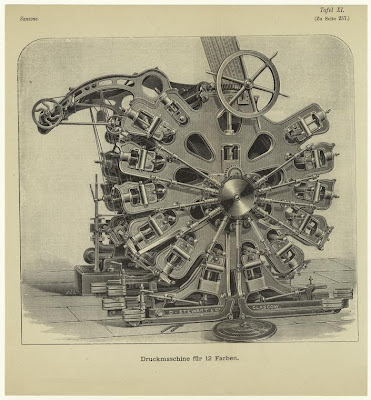
'Druckmaschine für zwölf Farben - [Printing machine
for 12 colors] - IN: Der Zeugdruch . Bleicherei, Färberei,
Druckerei und Appretur baumwollener Gewebe. 1890'
for 12 colors] - IN: Der Zeugdruch . Bleicherei, Färberei,
Druckerei und Appretur baumwollener Gewebe. 1890'
At the risk of repeating (??) myself, one of the strange (few) rules I impose upon myself is that I'm not allowed to visit any of the NYC library sites unless it's by 'accident' - from a search or from a secondary link. I don't ever steer the browser there as a primary destination. Partly this is because it's like shooting fish in a barrel so BibliOdyssey might just become a mirror site for their wonderful collections, in which case I would tend to feel a tad redundant; and partly it's because of the great swathes of time the sites steal from my life when I get there.
On this occasion, some forgotten search led me to the Picture Collection Online at the Mid-Manhattan Library, from where I staggered out after some hours or days with the above clutch of images.
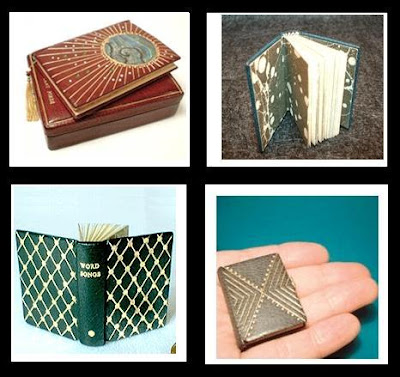

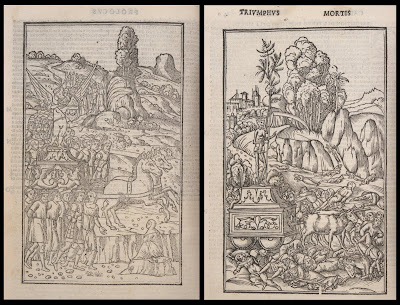
Left to right, top to bottom, Triumphs of Chastity and Time,
Love and Death. [I *think* they come from a latin translation
of Petrarch by Francesco Philelpho from the late 15th century]
Love and Death. [I *think* they come from a latin translation
of Petrarch by Francesco Philelpho from the late 15th century]

Hermes/Mercury Holding a Caduceus, Standing Over a Goat
IN: 'Inscriptiones sacrosanctae vetvstatis non illae qvidem romanae, sed
totivs fere orbis svmmo stvdio ac maximis' by Peter Apian early 16th cent.
IN: 'Inscriptiones sacrosanctae vetvstatis non illae qvidem romanae, sed
totivs fere orbis svmmo stvdio ac maximis' by Peter Apian early 16th cent.
The above 2 images again come from Cornell University's Rare Book and Manuscript Collection which I have steadily ransacked lately. Incidentally, this page gives a list of all the Luna Insight browser collections, including Cornell. They are kind of finicky but I've finally decided (after some substantial timesinks and trial and error) that I like them.
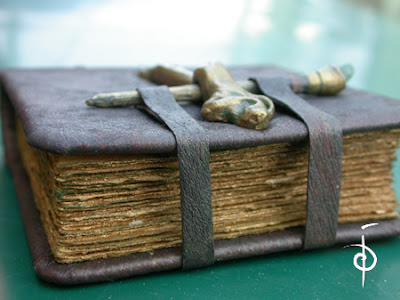


IN: 'Hungarian & Highland Broad Sword' by Henry Angelo, c.1790.
(previously) There are a whole host of fencing/combat manual links
from Todds Sabelhörna's website. The above image comes from a pdf at
the ARMA website. The rest of the grey scale book is filled with paintings of
moustachioed officers engaged in pitched sword battle aboard their trusty steeds.
(previously) There are a whole host of fencing/combat manual links
from Todds Sabelhörna's website. The above image comes from a pdf at
the ARMA website. The rest of the grey scale book is filled with paintings of
moustachioed officers engaged in pitched sword battle aboard their trusty steeds.

"13 maps; Draught of Boston harbour.; harbour of Placentia.; harbour of Anapolis Royal.; Plan of the town and harbour of Louisbourg in the island of Cape Breton ...; Draught of New York and Perthamboy Harbour.; Harbour of St. Augustine.; Harbour of Providence.; Havana.; Bay of St. Jago de Cuba.; Town and harbour of Charles Town in South Carolina.; Fort Royal in Martinico.; Plan of the town and harbour of Cartagena.; Plan of the harbour town and forts of Porto Bello when taken by Admiral Vernon on Nov. 22. 1739 with 6 ships only."
IN: 'A complete atlas or distinct view of the known world.' London : Printed for W. Innys, R. Ware, 1752. [from the University of South Florida Map Collection -- also accessible from the Luna Insight browser exhibits page via David Rumsey]


Bearing such imaginative names as 'decorated end paper' and
'marble paste paper', the Manchester Metropolitan University
Library has a vast collection of printed paper samples in their Image Archive. There are also book illustrations, artbooks and ceramics
on show but the paper samples make up the bulk of the online offerings.
'marble paste paper', the Manchester Metropolitan University
Library has a vast collection of printed paper samples in their Image Archive. There are also book illustrations, artbooks and ceramics
on show but the paper samples make up the bulk of the online offerings.

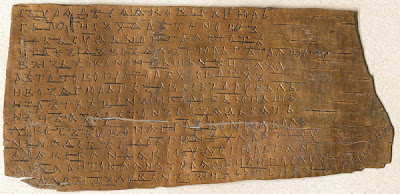
The Russian Birch Bark Library - more than 900 samples of
medieval birch writings from East Slavic peoples {11th to 15th centuries}.
The website is completely in russian - I just threw in random numbers to
the search field to retrieve these images. [page in english]
medieval birch writings from East Slavic peoples {11th to 15th centuries}.
The website is completely in russian - I just threw in random numbers to
the search field to retrieve these images. [page in english]

'Burgkmair, Hans, the elder 1493 - 1531 Gefecht (Hungarian Men)
39 from series The Triumph of Maximillian'
[from Bucknell University, Pennsylvania - Luna Insight browser collection]
39 from series The Triumph of Maximillian'
[from Bucknell University, Pennsylvania - Luna Insight browser collection]
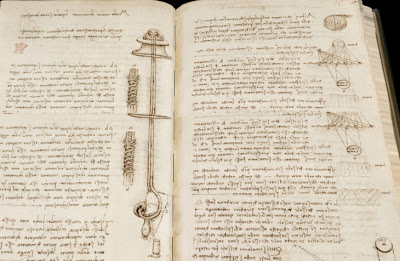




When Microsoft Vista was launched in the UK last week, Bill Gates announced that he had contributed a digital edition of a Leonardo da Vinci manuscript to the British Library's Turn The Pages site. So I went across there and downloaded a huge add-on to my XP platform so that I could view the Arundel manuscript, owned by the British Library - from which the above screencaps were taken. [more info/via]
Personally speaking, I find most of the turn the pages websites to be more gimmick than enhancement. This one in particular was a huge resources hog but at least the manuscript pages can be flipped to read Leonardo's mirrored writing (if medieval Italian is your thing). And to add insult to injury perhaps, I also think examining *some* of the Leonardo's manuscripts to be an overrated experience. I am generally more inclined towards the Leonardo sites that Bibi catalogued the other day (but there are lots more). I'm still not sure whether the manuscript Gates bought for $30 million in 1994 can be viewed without actually having the Vista operating system.
Speaking of the British Library...
"..the future of the British Library as a world-class, free resource is under threat from plans to cut up to 7 per cent of its £100m budget in this year's Treasury spending round.On a completely different and decidedly more uplifting note, go visit Le Divan Fumoir Bohémien.
To survive, the library proposes to slash opening hours by more than a third and to charge researchers for admission to the reading rooms for the first time.
All public exhibitions would close, along with schools learning programmes. The permanent collection, which includes a copy of every book published in the UK, would be permanently reduced by 15 per cent. And the national newspaper archive, used by 30,000 people a year, including many researching their family trees, would close."


